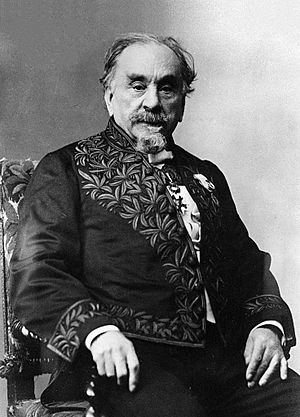Henri de Lacaze-Duthiers facts for kids
Félix Joseph Henri de Lacaze-Duthiers (born May 15, 1821 – died July 21, 1901) was an important French scientist. He was a biologist, an anatomist, and a zoologist. This means he studied living things, how bodies are built, and animals. He was especially good at studying mollusks, which are soft-bodied animals like snails and mussels.
Contents
A Life of Discovery
Henri de Lacaze-Duthiers was born in a town called Montpezat in France. He first studied medicine in Paris. While there, he worked at Necker Hospital.
Exploring Marine Life
Later, he traveled to the Balearic Islands with another scientist, Jules Haime. They went there to study animals that live in the ocean. In 1854, he returned to Paris. He became an assistant to Henri Milne-Edwards, another famous scientist. Soon after, he became a professor of zoology in Lille, France.
In 1865, he took over a special role at the National Museum of Natural History, France. He became the head of the department for mollusks, worms, and other simple marine animals. In 1868, he became a professor at the University of Paris. He was also chosen to join the French Academy of Sciences in 1871. This was a great honor for his work in anatomy and zoology.
Amazing Discoveries
Lacaze-Duthiers is well-known for his studies of marine animals. He looked closely at how mussels, coral, snails, and other ocean creatures are built. He also studied how they grow and develop.
In 1858, he found three types of mollusks in the Mediterranean Sea. These mollusks could make special purple-blue dyes. One of these species was called murex trunculus. This was the same type of mollusk that ancient people, like the Phoenicians, used to make their famous purple dye.
He even figured out how to use this dyeing process to create a special kind of photograph. He called this the "Mucographé" process. You can still see examples of these unique purple-blue images today. Some are kept at the Sorbonne in Paris and the Royal Society in London.
Studying Coral and Founding Labs
Henri de Lacaze-Duthiers was also a pioneer in studying marine life along the coast of Algeria. He did important scientific research on coral there. This research led to a book he published in 1864, called "Histoire naturelle du corail" (which means "Natural History of Coral").
He also started two important laboratories dedicated to marine biology. The first was the biological station at Roscoff, which opened in 1876. The second was the Arago laboratory at Banyuls-sur-Mer, opened in 1882. These labs allowed scientists to study ocean life up close.
Many different species of animals are named after him. Some examples include Strophomenia lacazei, Convoluta lacazi, and Dileptus lacazei. In 1872, he also started a scientific journal. It was called "Archives de zoologie expérimentale et générale" (Archives of Experimental and General Zoology). This journal helped scientists share their new discoveries.



